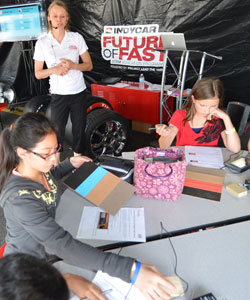Montgomery Village Middle School science teacher Kathryn Spivey was making mental notes as five groups of students bounded from pod to pod to participate in activities that relate their schoolwork to the world – present and future.
Students were fully engaged in the Future of Fast program sponsored by INDYCAR and administered by Project Lead the Way, which conveys through field trip participation the importance of science, technology, engineering and math and how they relate to IndyCar racing.
The program, announced in May, opened soon after Maryland schools returned to session in association with the INDYCAR races in Baltimore. A subsequent program was held in Houston last week and the final one of 2013 associated with a race weekend will be in Fontana., Calif., next week.
“It gave them a chance to do science hands-on with equipment we can’t afford to put in the classroom, and they were able to see what we’re talking about when we talk about being safe and friction and motion," Spivey said. “It was an experience I don’t think (the students) will ever have and, as a teacher, I think part of my job is to give them experiences they won’t have and to make connections to what they are doing in the classroom.”
 Elijah Hyson connected the dots in testing which soda -- hot or cold -- would create gas fastest when yeast interacted with the sugar in the soda. It’s an example of the fermentation process of making denatured ethanol that is mixed with gasoline to power the IZOD IndyCar Series engines. Rubber gloves were placed over the cans to restrict oxygen.
Elijah Hyson connected the dots in testing which soda -- hot or cold -- would create gas fastest when yeast interacted with the sugar in the soda. It’s an example of the fermentation process of making denatured ethanol that is mixed with gasoline to power the IZOD IndyCar Series engines. Rubber gloves were placed over the cans to restrict oxygen.
“The cold one was slow, the hot one was faster, but the cold one got biggest. Cool,” he said.
Seeing Hyson’s wide-eyed discovery induced a smile from Dr. Vince Bertram, CEO and president of Project Lead the Way, which provides STEM education curriculum to the program and middle schools and high schools across the nation.
“We’re very excited about this partnership,” he said. “Taking the nation’s leading provider of STEM curriculum and putting it together with one of the world’s iconic brands and enterprises to give students a hands-on experience is very exciting and dynamic.
“The thing that’s so important in education is that we often teach disciplines in isolation. Students don’t understand the relevancy of what they’re doing. This makes it real. They get to apply match and science in rigorous ways but also fun ways.”
Other learning pods are dedicated to:
• Wind tunnel introduction -- A specially designed wing uses the same lift principle that allows aircrafts to fly. However, IndyCars use an inverted lift principle, forcing the car down. Students measure the performance of a model IndyCar wing in a wind tunnel.
• Human horsepower introduction – Students determine how much horsepower individuals on a team produce and then calculate the total horsepower of the team. They also compare their total horsepower to that of the 2.2-liter, turbocharged V6 IndyCar engine.
• SAFER Barrier introduction – The Steel and Foam Energy Reduction barrier is constructed of steel tubes and bundles of polystyrene between the concrete wall and the steel tubing modules. Students design, build and test a SAFER Barrier using simple construction supplies.
• Grip introduction -- Aerodynamic grip is increased by controlling the air flow around, over and under the car to create downforce. Mechanical grip increased by changes to the suspension, steering, tire camber, and tire material. Students compare the grip of various materials against a friction board.
IZOD IndyCar Series driver/team owner Ed Carpenter said the program sparks the curiosity of students, who don’t necessarily examine or understand the science, technology and engineering of what they take in visually is produced or how it works.
“Everything that we do here with these race cars, whether what keeps us safe in an accident or what’s helping us go fast on the track, it’s an engineering-driven sport, which the heart of it is math and science," Carpenter said.
“This allows them to examine the technical aspects and the engineering behind it all to allow cars to go 200 mph but allow them to stay on the ground in an entertainment environment.”
The program will expand to all domestic race markets during the 2014 season, led by Project Lead the Way facilitators.
“We hope that through this experience they get in the car next time with mom and dad and say ‘Did you know?’ And they have a level of knowledge,” Bertram said. “We often say to our teachers that an effective teacher isn’t someone who poses questions that students have a difficult time answering.
“It’s when the students ask a question that the teacher has a difficult time answering. That’s really when you get kids thinking in a deep way, and that’s what we’re trying to do here.”
